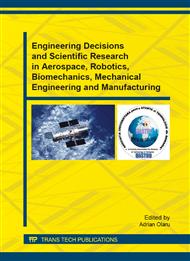p.238
p.247
p.255
p.265
p.271
p.277
p.287
p.295
p.303
Oscillatory Movements Analysis at Knee Level
Abstract:
Some theoretical and experimental considerations upon the biomechanics of oscillatory flexion-extension movements developed at knee level of human subjects, without previous detected pathologies are presented in this paper. Thus, the first part of the paper is referring to the analysis of aspects related to the locomotion system biomechanics concerning the flexion-extension movement at knee level and also to the setting of various samples of subjects out of which the examples for the proposed methodology application will be selected. In the second part of the paper, the analysis structures required for the recording and assessment of oscillatory movements biomechanics at knee level are developed and presented. In the third part, the results and conclusions regarding the behavior and performance limits of movements at knee level are presented and processed.
Info:
Periodical:
Pages:
271-276
Citation:
Online since:
October 2013
Authors:
Keywords:
Price:
Сopyright:
© 2013 Trans Tech Publications Ltd. All Rights Reserved
Share:
Citation:


